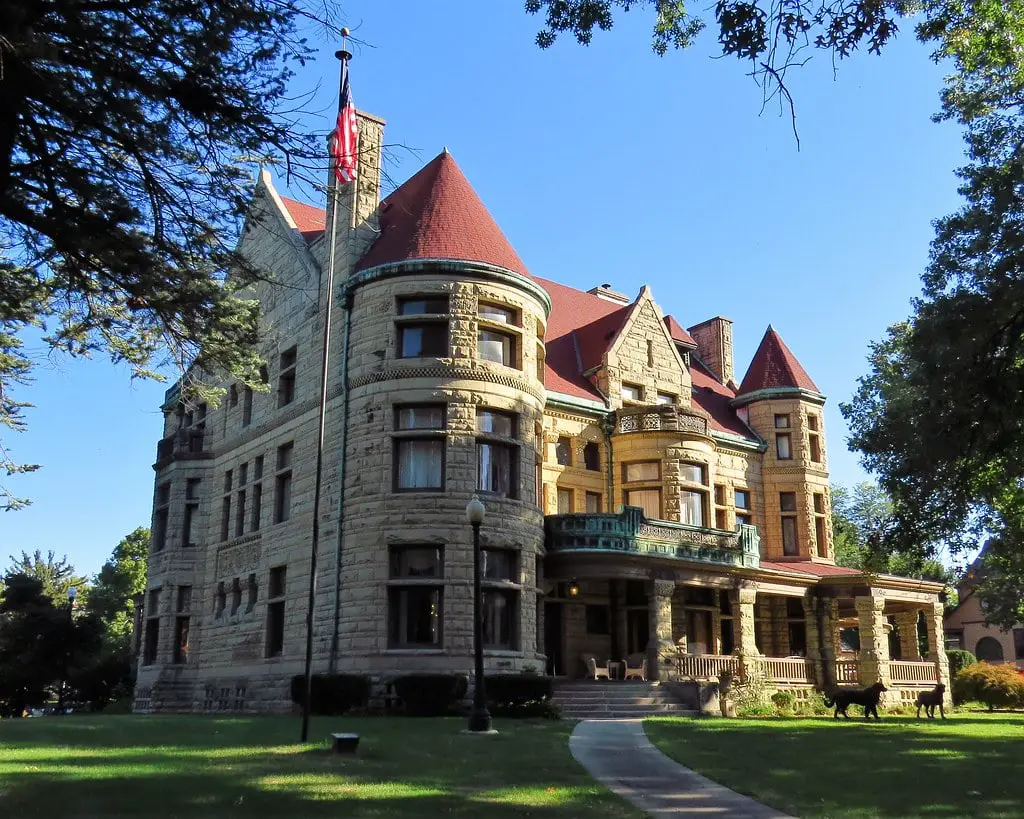Quincy Museum: A Testament to Timeless Elegance
In the heart of Quincy, Illinois, stands a remarkable edifice that harks back to a bygone era of architectural grandeur: the Richard F. Newcomb House.
Constructed between 1890 and 1891, this historic house is a stunning example of Richardsonian Romanesque design, a style characterized by its robust, medieval-inspired aesthetics.
The house’s exterior, crafted from massive limestone blocks, exudes timeless elegance. Its red shingled roof, a distinctive feature of the Romanesque style, adds a vibrant contrast to the stone facade.
The house’s wraparound front porch, supported by sturdy limestone pillars, extends a warm invitation to visitors, beckoning them to step into a world steeped in history.
Adding to the house’s architectural charm are two distinctive towers: a sizeable conical tower from the southwest corner and a smaller octagonal tower at the southeast. These towers’ intricate detailing adds a touch of whimsy to the house’s otherwise imposing structure.
The design of this house was a collaborative effort between local architects Harvey Chatten and Ernest M. Wood, who drew inspiration from the recently built William S. Warfield House, another architectural gem of Quincy.

The Man Behind the House: A Visionary and a Dream
The house was commissioned by Richard F. Newcomb, a man who left an indelible mark on Quincy’s history. Newcomb founded the Quincy Paper Company, a firm that eventually gained national recognition for producing strawboard, a paperboard made from straw.
Newcomb’s vision for his home was not merely to create a comfortable living space. He aspired to construct a structure that would outshine the William S. Warfield House, which he greatly admired. His ambition was realized in the Newcomb House, a building testament to his vision and determination.
The Transition of Ownership: A New Chapter in the House’s History
In 1910, the Newcomb House saw a change of ownership. It was bought by John A. Stillwell, Newcomb’s son-in-law. Stillwell, the Electric Wheel Company president, maintained the house’s grandeur, preserving its architectural features and ensuring its upkeep.

In a generous act of philanthropy, the Stillwell family donated the house to Quincy College in 1941. The college, recognizing the house’s historical value, repurposed it as a women’s dormitory. This added another chapter to the house’s rich history, transforming it from a private residence into a place of learning and growth.
The House’s Place in History: A Symbol of Quincy’s Past
The Richard F. Newcomb House earned a distinguished place on the National Register of Historic Places on the 3rd of June, 1982. This recognition cemented its place in Quincy’s local history and acknowledged its architectural significance.
The house stands not just as a beautiful piece of architecture but as a symbol of Quincy’s past, its industrial growth, and its architectural evolution.

The Quincy Museum: A Treasure Trove of History
Today, the Richard F. Newcomb House is home to the Quincy Museum, which brings history to life. The museum is a treasure trove of local history, natural history, and exhibits on dinosaurs and area Native Americans.
The house’s first floor has been meticulously restored, allowing visitors to step back in time and experience the place as it was in its early days. Meanwhile, the second and third floors have been transformed into engaging exhibits that educate and inspire.
The Museum Today: Bringing History to Life
The Quincy Museum continues to thrive, offering interactive audio and video exhibits that bring more than 400 years of America’s rich history to life. The museum provides a unique glimpse into the past, from the stories of rebels and reformers who helped shape the United States to the tales of workers who moved 5-ton granite blocks.
The museum pays tribute to the enterprising individuals who have influenced America’s development. It showcases exhibits that honor the creators of America’s 28 ice cream flavors, pioneers of the do-it-yourself home repair movement, and innovators of drive-thru coffee and doughnut services.

These stories of innovation and determination serve as a reminder of the ingenuity and resilience that have shaped the nation.
Conclusion: A Legacy of History and Inspiration
The enduring legacy of the Richard F. Newcomb House and the Quincy Museum is a testament to Quincy’s rich history. These landmarks serve as a reminder of the city’s past while inspiring future generations. They are not just buildings but repositories of stories, memories, and lessons from our past.
So, take a moment to step back in time and explore the rich tapestry of history, the Richard F. Newcomb House, and the Quincy Museum.
Experience the grandeur of the house, learn from the exhibits, and let the stories of the past inspire you. These landmarks are not just part of Quincy’s history; they are part of America’s story.
